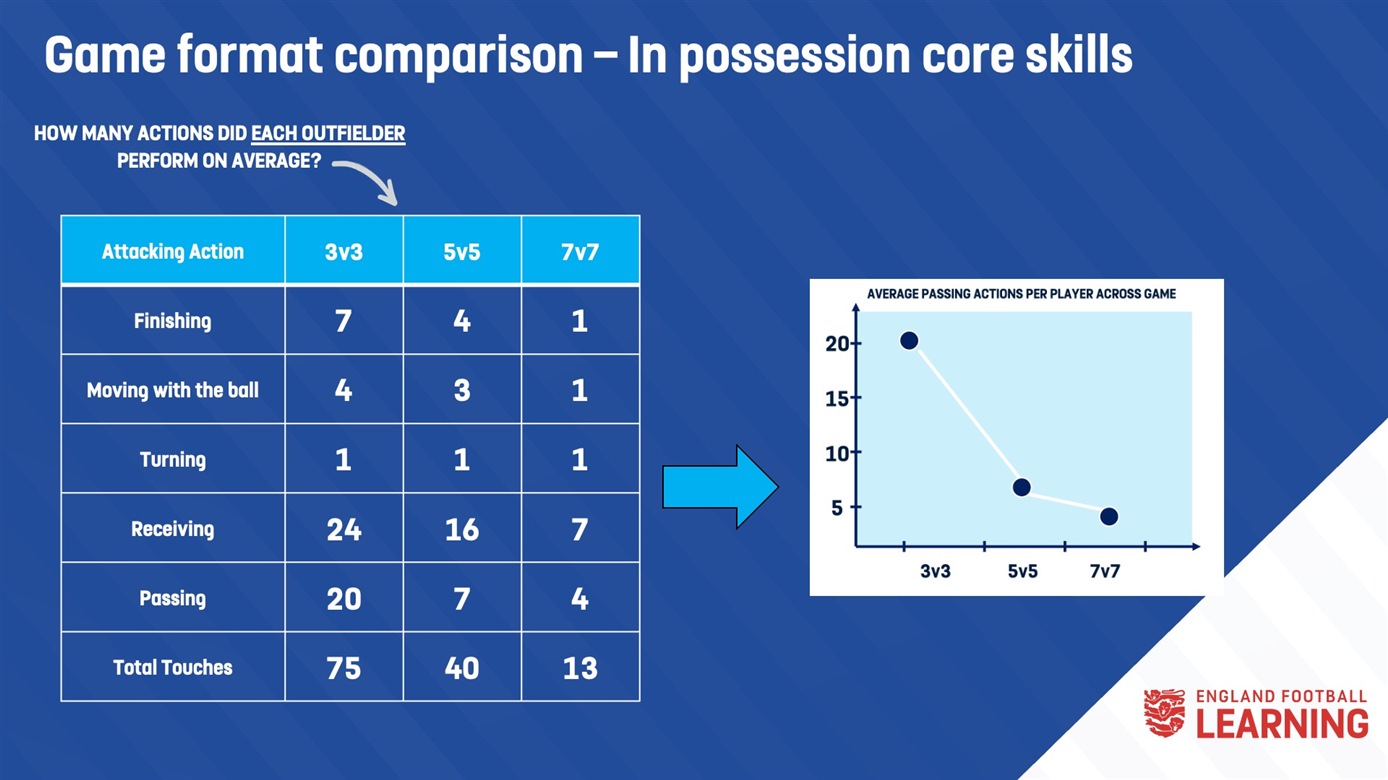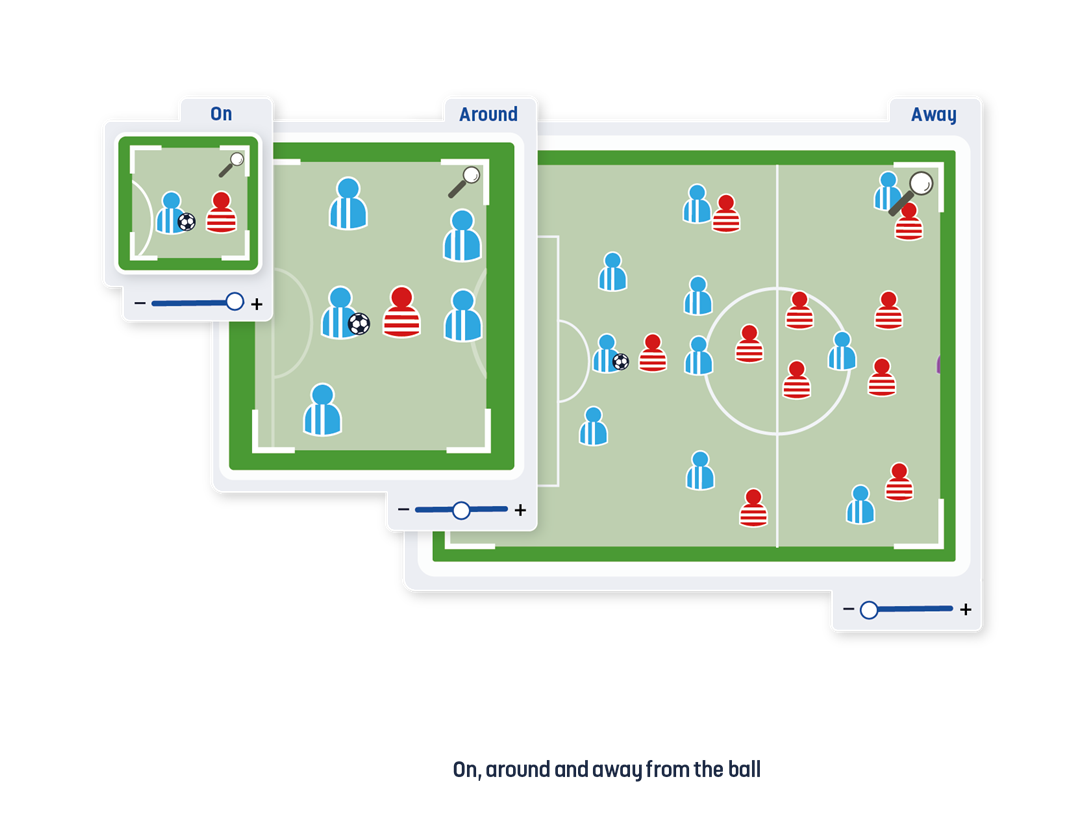We’ve discussed in previous blogs that if you want to give your players the opportunity to practice core skills with high levels of repetition, small-sided games such as 3v3 are key. But have you ever stopped to think how these formats can also provide game realistic challenges for your players to solve, that link to the largest format they may play?
Game formats and core skills
Analysing a series of 20-minute games, we found that playing 3v3 provided a group of U9 grassroots players the opportunity to receive the ball an average of 24 times. In addition to this, players were also provided the opportunity to have 7 shots on goal. This decreases as they move through the formats to receiving just 7 times, with just 1 shot on goal per 20-minute period of playing 7v7. We see a similar story when observing U14 boys playing in the talent development space, receiving the ball just 10 times in 11v11 compared to 30 times at 3v3.

What is a game within the game?
When you watch your favourite team perform at the weekend you will see two groups of players doing what it takes to get the result they crave. However, look a little closer and you are likely to see many small number battles taking place. We refer to this as a ‘game within the game’ and they can be defined as “scenarios featuring a small number of players, occurring within moments of the game, in which they may be underloaded, matched up, or overloaded.”
How can you identify a game within the game?
When we apply the observational principles of on, around, and away from the ball we can see many different elements at play:

Individual – what individual tactics does your player deploy to gain an advantage over their direct opponent?
2s and 3s – how do your players link core skills and core moves to individual and group tactics, and what impact does this have on your game model?
Unit – how do your players interact with other units to progress the ball up the pitch?
Team – what tactics and strategies are being deployed to create an advantage over your opponent?
The concept of game within the game uses a combination of these factors to place emphasis on the smaller number scenarios occurring and focuses on how your players adopt the principles of play to gain an advantage over their opponent. In the example below we demonstrate how you can use this concept of on, around and away from the ball to better observe how your players work together, and how the game within the game scenario, in this case a 4 vs 4 plays a key role in the wider game.
Number scenarios
Although the game you prepare your players for at the weekend generally contains equal numbers on both sides and are therefore matched up (e.g. 11v11, 7v7), when you look closely you will see many scenarios taking place in certain areas of the pitch where your players may be underloaded or overloaded (see examples below). Keeping this in mind, it is important we provide a practice environment for our players which expose them to these different scenarios, providing both the appropriate level of challenge and success based on the age and stage of the players we work with.
Matched up
A team or group of players is matched up when they have the same number of players as their opponent in a specific area of the pitch. When this scenario occurs, it can often become a small game of 1v1 battles, where movement to disrupt and invite pressure is critical to create space to link and combine with team-mates. In this case Anthony Gordon makes a forward run to create space and a 5v5 game within the game appears. Jude Bellingham supports Rico Lewis behind the ball before receiving and playing a straight pass for a diagonal run. This two-player core move exploits Greece’s high line and creates space for Gordon to run into.
This scenario demonstrates the how practicing phases of play can be a great way of exposing your players to specific situations they may face on a match day, particularly if they are performed in the right area of the pitch. Getting your players working together in this way can be great for building relationships and team cohesion as they must work together to find the best way of solving the game problem, resulting in lots of trial and error on the training pitch, which can reap huge rewards on a match day.
Underload
An underload occurs when one team has fewer players than their opponent in a specific area of the pitch and therefore face a numerical disadvantage. In the video below from the WSL Manchester City move the ball into a wide area and face a 4 vs 5 underload against Bristol City. Underloads are a common feature when a team is looking to create or finish an attack and in this situation the Man City players must find a way of working together to create space and penetrate by disrupting Bristol City’s defensive structure. This is achieved through players making movements away from the ball to either receive the ball or create space for their team-mates. The resulting play is a clever two player connection between Chloe Kelly and Mary Fowler with the latter using an overlap to receive in space behind Liverpool’s defence.
Not only does this demonstrate the importance of practice design to get your players comfortable receiving and playing in tight areas but also highlights how multi-directional practices within training can transfer seamlessly into the match day environment.
Overload
An overload occurs when one team has more players than their opponent in a specific area of the pitch and therefore have a numerical advantage. This is a situation we often see when a team is defending in a low block and can get pressure on the ball with plenty of support from nearby team-mates. With the ball, one area teams may try and overload their opponent in is wide areas, and this is demonstrated in the video below.
With Manchester City looking to build an attack against Aston Villa they apply the principles of creating space by positioning their players in high, wide and deep positions, therefore, making the distances bigger between Aston Villa’s defensive units and creating a 4v3 overload in Manchester City’s favour. In this instance Chloe Kelly provides the height, while full back Kerstin Casparij adopts a deeper and wide position. From here we see centre midfielder Jess Park dropping deep to receive and play a first-time pass round the corner to Caparij, breaking Aston Villa’s press and allowing City to progress up the pitch.
Summary
Although the wider game may be 11v11 or 9v9, if you look closely, you will see many small number battles taking place all over the pitch. Homing in your observation skills to look on, around and away from the ball will help you notice where these are taking place, and how your players respond to being either matched up, overloaded, or underloaded. Exposing your players to these scenarios in training is a sure-fire way to prepare them for the game problems they may face on a match day.
Want more?
Further resources:
Article –Three player core moves
Sessions – Finishing session: overloads, underloads and matched-up numbers
Blog – Using game insight to inform practice design
Coaching cards – How to develop styles of play


